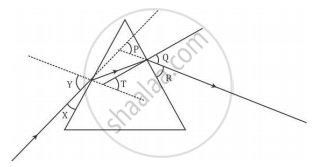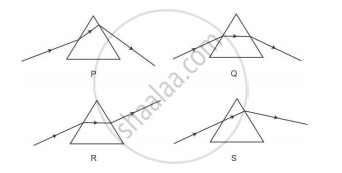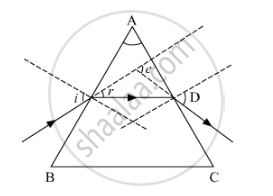Advertisements
Advertisements
Question
In an experiment to trace the path of a ray of light through a triangular glass prism, a student would observe that the emergent ray
(a) is parallel to the incident ray.
(b) is along the same direction of incident ray.
(c) gets deviated and bends towards the thinner part of the prism.
(d) gets deviated and bends towards the thicker part (base) of the prism.
Solution
In an experiment to trace the path of a ray of light through a triangular glass prism, a student would observe that the emergent ray gets deviated and bends towards the thicker part (base) of the prism.
Hence, the correct answer is option (d).
APPEARS IN
RELATED QUESTIONS
In the following diagram, the path of a ray of light passing through a glass prism is shown:

In this diagram the angle of incidence, the angle of emergence and the angle of deviation respectively are (select the correct option):
(A) X, R and T
(B) Y, Q and T
(C) X, Q and P
(D) Y, Q and P
Study the following diagrams in which the path of a ray of light passing through a glass prism as traced by four students P, Q, R and S is shown:

The student who has traced the path correctly is
(A) P
(B) Q
(C) R
(D) S
Study the following figure in which a student has marked the angle of incidence (∠i), angle of refraction (∠r), angle of emergence (∠e), angle of prism (∠A) and the angle of deviation (∠D). The correctly marked angles are

(a) ∠A and ∠i
(b) ∠A, ∠i and ∠r
(c) ∠A, ∠i, ∠e and ∠D
(d) ∠A, ∠i, ∠r and ∠D
What will happen if another similar glass prism is placed upside down behind the first prism?
A beam of white light is shone onto a glass prism. The light cannot be:
(a) deviated
(b) dispersed
(c) focused
(d) refracted
The splitting up of white light into seven colours on passing through a glass prism is called:
(a) refraction
(b) deflection
(c) dispersion
(d) scattering
A ray of white light falls on a prism. Draw a ray diagram to show that the prism disperses the white light.
An object is placed in front of a converging lens and in front of a diverging lens as in fig.

(a)Complete the ray diagram to obtain an image.
(b)Compare the nature of image formed by both the lenses in the above case.
______ colour is deviated the least in the spectrum of white light obtained with a glass prism.
The angle of deviation through a prism is minimum when

- Incident rays and emergent rays are symmetric to the prism.
- The refracted ray inside the prism becomes parallel to its base.
- The angle of incidence is equal to that of the angle of emergence.
- When the angle of emergence has doubled the angle of incidence.
Choose the correct answer from the options given below:
